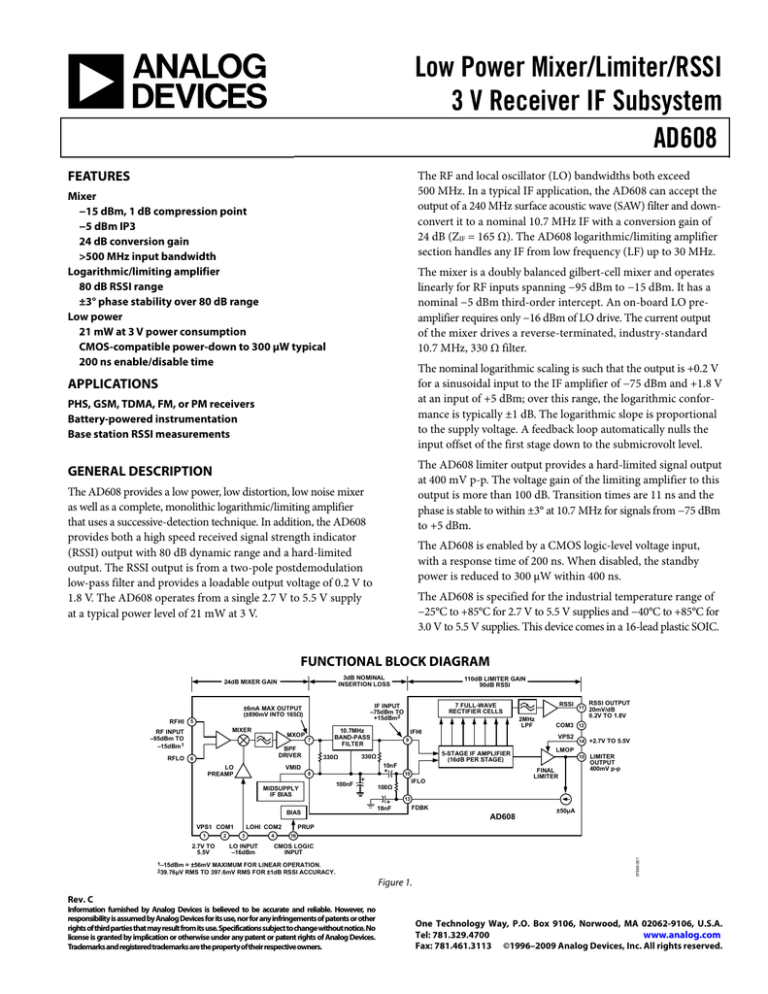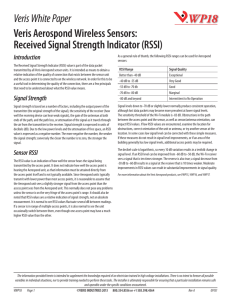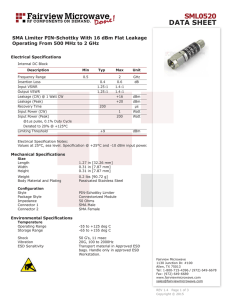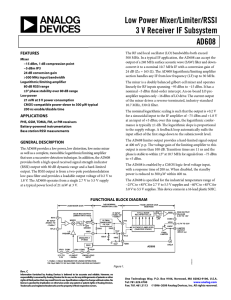
Low Power Mixer/Limiter/RSSI
3 V Receiver IF Subsystem
AD608
The RF and local oscillator (LO) bandwidths both exceed
500 MHz. In a typical IF application, the AD608 can accept the
output of a 240 MHz surface acoustic wave (SAW) filter and downconvert it to a nominal 10.7 MHz IF with a conversion gain of
24 dB (ZIF = 165 Ω). The AD608 logarithmic/limiting amplifier
section handles any IF from low frequency (LF) up to 30 MHz.
FEATURES
Mixer
−15 dBm, 1 dB compression point
−5 dBm IP3
24 dB conversion gain
>500 MHz input bandwidth
Logarithmic/limiting amplifier
80 dB RSSI range
±3° phase stability over 80 dB range
Low power
21 mW at 3 V power consumption
CMOS-compatible power-down to 300 μW typical
200 ns enable/disable time
The mixer is a doubly balanced gilbert-cell mixer and operates
linearly for RF inputs spanning −95 dBm to −15 dBm. It has a
nominal −5 dBm third-order intercept. An on-board LO preamplifier requires only −16 dBm of LO drive. The current output
of the mixer drives a reverse-terminated, industry-standard
10.7 MHz, 330 Ω filter.
The nominal logarithmic scaling is such that the output is +0.2 V
for a sinusoidal input to the IF amplifier of −75 dBm and +1.8 V
at an input of +5 dBm; over this range, the logarithmic conformance is typically ±1 dB. The logarithmic slope is proportional
to the supply voltage. A feedback loop automatically nulls the
input offset of the first stage down to the submicrovolt level.
APPLICATIONS
PHS, GSM, TDMA, FM, or PM receivers
Battery-powered instrumentation
Base station RSSI measurements
The AD608 limiter output provides a hard-limited signal output
at 400 mV p-p. The voltage gain of the limiting amplifier to this
output is more than 100 dB. Transition times are 11 ns and the
phase is stable to within ±3° at 10.7 MHz for signals from −75 dBm
to +5 dBm.
GENERAL DESCRIPTION
The AD608 provides a low power, low distortion, low noise mixer
as well as a complete, monolithic logarithmic/limiting amplifier
that uses a successive-detection technique. In addition, the AD608
provides both a high speed received signal strength indicator
(RSSI) output with 80 dB dynamic range and a hard-limited
output. The RSSI output is from a two-pole postdemodulation
low-pass filter and provides a loadable output voltage of 0.2 V to
1.8 V. The AD608 operates from a single 2.7 V to 5.5 V supply
at a typical power level of 21 mW at 3 V.
The AD608 is enabled by a CMOS logic-level voltage input,
with a response time of 200 ns. When disabled, the standby
power is reduced to 300 μW within 400 ns.
The AD608 is specified for the industrial temperature range of
−25°C to +85°C for 2.7 V to 5.5 V supplies and −40°C to +85°C for
3.0 V to 5.5 V supplies. This device comes in a 16-lead plastic SOIC.
FUNCTIONAL BLOCK DIAGRAM
3dB NOMINAL
INSERTION LOSS
24dB MIXER GAIN
5
MIXER
RFLO
MXOP
7
BPF
DRIVER
6
LO
PREAMP
10.7MHz
BAND-PASS
FILTER
330Ω
10nF
8
MIDSUPPLY
IF BIAS
100nF
+
2
3
4
15
LIMITER
OUTPUT
400mV p-p
13
FDBK
AD608
±50µA
PRUP
LOHI COM2
LO INPUT
–16dBm
IFLO
14 +2.7V TO 5.5V
LMOP
16
CMOS LOGIC
INPUT
07886-001
1
2.7V TO
5.5V
18nF
0.2V TO 1.8V
FINAL
LIMITER
10
100Ω
+
BIAS
VPS1 COM1
5-STAGE IF AMPLIFIER
(16dB PER STAGE)
RSSI OUTPUT
11 20mV/dB
COM3 12
VPS2
9
330Ω
VMID
2MHz
LPF
IFHI
+
RFHI
RSSI
7 FULL-WAVE
RECTIFIER CELLS
IF INPUT
–75dBm TO
+15dBm2
±6mA MAX OUTPUT
(±890mV INTO 165Ω)
RF INPUT
–95dBm TO
–15dBm 1
110dB LIMITER GAIN
90dB RSSI
1–15dBm = ±56mV MAXIMUM FOR LINEAR OPERATION.
239.76µV RMS TO 397.6mV RMS FOR ±1dB RSSI ACCURACY.
Figure 1.
Rev. C
Information furnished by Analog Devices is believed to be accurate and reliable. However, no
responsibility is assumed by Analog Devices for its use, nor for any infringements of patents or other
rights of third parties that may result from its use. Specifications subject to change without notice. No
license is granted by implication or otherwise under any patent or patent rights of Analog Devices.
Trademarks and registered trademarks are the property of their respective owners.
One Technology Way, P.O. Box 9106, Norwood, MA 02062-9106, U.S.A.
Tel: 781.329.4700
www.analog.com
Fax: 781.461.3113 ©1996–2009 Analog Devices, Inc. All rights reserved.
AD608* Product Page Quick Links
Last Content Update: 08/30/2016
Comparable Parts
Design Resources
View a parametric search of comparable parts
• AD608 Evaluation Board
•
•
•
•
Documentation
Discussions
Data Sheet
• AD608: Low Power Mixer/Limiter/RSSI 3V Receiver IF
Subsystem Data Sheet
View all AD608 EngineerZone Discussions
Evaluation Kits
Tools and Simulations
• ADIsimPLL™
• ADIsimRF
AD608 Material Declaration
PCN-PDN Information
Quality And Reliability
Symbols and Footprints
Sample and Buy
Visit the product page to see pricing options
Technical Support
Submit a technical question or find your regional support
number
Reference Materials
Analog Dialogue
• Maximizing Battery Life in Communications Systems
* This page was dynamically generated by Analog Devices, Inc. and inserted into this data sheet. Note: Dynamic changes to
the content on this page does not constitute a change to the revision number of the product data sheet. This content may be
frequently modified.
AD608
TABLE OF CONTENTS
Features .............................................................................................. 1 Mixer ...............................................................................................9 Applications ....................................................................................... 1 Mixer Gain .....................................................................................9 General Description ......................................................................... 1 IF Filter Terminations ................................................................ 10 Functional Block Diagram .............................................................. 1 The Logarithmic IF Amplifier .................................................. 10 Revision History ............................................................................... 2 Offset Feedback Loop ................................................................ 10 Specifications..................................................................................... 3 RSSI Output ................................................................................ 11 Absolute Maximum Ratings............................................................ 4 Digitizing the RSSI ..................................................................... 11 Thermal Resistance ...................................................................... 4 Power Consumption .................................................................. 11 ESD Caution .................................................................................. 4 Troubleshooting.......................................................................... 11 Pin Configuration and Function Descriptions ............................. 5 Applications Information .............................................................. 12 Typical Performance Characteristics ............................................. 6 Outline Dimensions ....................................................................... 13 Test Circuits ....................................................................................... 8 Ordering Guide .......................................................................... 13 Theory of Operation ........................................................................ 9 REVISION HISTORY
2/09—Rev. B to Rev. C
Updated Format .................................................................. Universal
Reorganized Layout ............................................................ Universal
Change to General Description Section ........................................ 1
Changes to DC Level Parameter, Operating Range Parameter,
and TMIN to TMAX Parameter, Table 1 .......................................... 3
Added Typical Performance Characteristics Heading ................ 6
Added Test Circuits Heading .......................................................... 8
Changes to Figure 17 and Figure 19 ............................................... 8
Change to Figure 22 ......................................................................... 9
Changes to Table 5 ............................................................................ 9
Updated Outline Dimensions ....................................................... 13
Changes to Ordering Guide .......................................................... 13
Rev. C | Page 2 of 16
AD608
SPECIFICATIONS
TA = 25°C, supply = 3 V, dBm is referred to 50 Ω, unless otherwise noted.
Table 1.
Parameter
MIXER PERFORMANCE
RF and LO Frequency Range
LO Power
Conversion Gain
Noise Figure
1 dB Compression Point
Third-Order Intercept
Input Resistance
Input Capacitance
LIMITER PERFORMANCE
Gain
Limiting Threshold
Input Resistance
Input Capacitance
Phase Variation
DC Level
Output Level
Rise and Fall Times
Output Impedance
RSSI PERFORMANCE
Nominal Slope
Nominal Intercept
Minimum RSSI Voltage
Maximum RSSI Voltage
RSSI Voltage Intercept
Logarithmic Linearity Error
RSSI Response Time
Output Impedance
POWER-DOWN INTERFACE
Logic Threshold
Input Current
Power-Up Response Time
Power-Down Response Time
Power-Down Current
POWER SUPPLY
Operating Range
Powered Up Current
OPERATING TEMPERATURE
TMIN to TMAX
1
Conditions 1
Min
Input terminated in 50 Ω
Driving doubly terminated 330 Ω IF filter, ZIF = 165 Ω
Matched input, fRF = 100 MHz
Matched input, fRF = 240 MHz
Input terminated in 50 Ω
fRF = 240 MHz and 240.02 MHz, fLO = 229.3 MHz
fRF = 100 MHz (see Table 5)
fRF = 100 MHz (see Table 5)
19
Full temperature and supply range
3° rms phase jitter at 10.7 MHz
280 kHz IF bandwidth
−75 dBm to +5 dBm IF input signal at 10.7 MHz
Center of output swing (VPOS – 1 V)
Limiter output driving 5 kΩ load
Driving a 5 pF load
At 10.7 MHz
At VPOS = 3 V; proportional to VPOS
−75 dBm input signal
+5 dBm input signal
0 dBm input signal
−75 dBm to +5 dBm input signal at IFHI
90% RF to 50% RSSI
At midscale
17.27
Typ
500
−16
24
11
16
−15
−5
1.9
3
−25°C to +85°C
−40°C to +85°C
VPOS = 3 V
2.7
3.0
VPOS = 2.7 V to 5.5 V
VPOS = 3.0 V to 5.5 V
−25
−40
28
Rev. C | Page 3 of 16
MHz
dBm
dB
dB
dB
dBm
dBm
kΩ
pF
dB
dBm
10
3
±3
2
400
11
200
kΩ
pF
Degrees
V
mV p-p
ns
Ω
20
−85
0.2
1.8
23.27
±1
200
250
mV/dB
dBm
V
V
V
dB
ns
Ω
1.5
75
200
400
100
V
mA
ns
ns
μA
1.82
5.5
5.5
V
V
mA
+85
+85
°C
°C
7.3
VPOS is used to refer collectively to the VPS1 and VPS2 pins.
Unit
110
−75
1.57
System active on logic high
For logic high
Active limiter output
To 200 μA supply current
Max
AD608
ABSOLUTE MAXIMUM RATINGS
THERMAL RESISTANCE
Table 2.
Parameter
Supply Voltages VPS1, VPS2
Internal Power Dissipation
Temperature Range
Storage Temperature Range
Lead Temperature (Soldering 60 sec)
θJA is specified for the worst-case conditions, that is, a device
soldered in a circuit board for surface-mount packages.
Rating
+6 V
600 mW
−40°C to +85°C
−65°C to +150°C
300°C
Table 3.
Package Type
16-Lead SOIC
Stresses above those listed under Absolute Maximum Ratings
may cause permanent damage to the device. This is a stress
rating only; functional operation of the device at these or any
other conditions above those indicated in the operational
section of this specification is not implied. Exposure to absolute
maximum rating conditions for extended periods may affect
device reliability.
ESD CAUTION
Rev. C | Page 4 of 16
θJA
110
Unit
°C/W
AD608
PIN CONFIGURATION AND FUNCTION DESCRIPTIONS
VPS1 1
16
PRUP
COM1 2
15
LMOP
LOHI 3
14
VPS2
COM2 4
AD608
RFLO 6
11
RSSI
MXOP 7
10
IFLO
VMID 8
9
IFHI
07886-002
13 FDBK
TOP VIEW
RFHI 5 (Not to Scale) 12 COM3
Figure 2. Pin Configuration
Table 4. Pin Function Descriptions
Pin No.
1
2
3
4
5
6
7
8
9
10
11
12
13
14
15
16
1
Mnemonic
VPS1 1
COM1
LOHI
COM2
RFHI
RFLO
MXOP
VMID
IFHI
IFLO
RSSI
COM3
FDBK
VPS21
LMOP
PRUP
Description
Positive Supply Input
Common
Local Oscillator Input Connection
Common
RF Input, Noninverting
RF Input, Inverting
Mixer Output
Midpoint Supply Bias Output
IF Input, Noninverting
IF Input, Inverting
Received Signal Strength Indicator Output
Output Common
Offset-Null Feedback Loop Output
Limiter Positive Supply Input
Limiter Output
Power-Up
VPOS is used to refer collectively to the VPS1 and VPS2 pins in this data sheet.
Rev. C | Page 5 of 16
AD608
3.0
24.5
2.5
24.0
2.0
RSSI OUTPUT (V)
25.0
23.5
23.0
1.0
50
100
150
200
250
300
350
400
450
500
0
–80
RF FREQUENCY (MHz)
3
–2
2
RSSI ERROR (dB)
–1
–3
–4
–5
50
60
70
–10
0
10
80
IF FREQUENCY (MHz)
10
3V
5V
–3
40
–20
–1
–7
30
–30
0
–2
20
–40
1
–6
–4
–80
07886-006
MIXER RESPONSE (dB)
4
10
–50
Figure 6. IF RSSI Output vs. Input Power and Temperature,
3 V Supply (See Figure 15)
0
0
–60
INPUT POWER (dBm)
Figure 3. Mixer Conversion Gain vs. RF Frequency
–8
–70
07886-008
0
07886-010
0.5
22.5
22.0
+85°C
+25°C
–25°C
1.5
07886-005
MIXER CONVERSION GAIN (dB)
TYPICAL PERFORMANCE CHARACTERISTICS
–70
–60
–50
–40
–30
–20
–10
0
INPUT POWER (dBm)
Figure 7. RSSI Error vs. Input Power
(See Figure 15)
Figure 4. Mixer IF Port Bandwidth
3.0
800mV/DIV
RSSI
2.0
100ns/DIV
5V
1.5
1V/DIV
1.0
3V
0.5
–70
–60
–50
–40
–30
–20
INPUT POWER AT IFHI (dBm)
–10
0
10
07886-007
100ns/DIV
0
–80
Figure 5. IF RSSI Output vs. Input Power at IFHI and Supply Voltage,
Ambient Temperature (See Figure 15)
Figure 8. RSSI Power-Up Response
(See Figure 19)
Rev. C | Page 6 of 16
07886-011
PRUP
RSSI OUTPUT (V)
2.5
AD608
5
200mV/DIV
4
RSSI
LIMITER PHASE (Degrees)
IFHI
3
2
1
0
–1
–2
50ns/DIV
–4
–5
–80
–70
–60
–50
–40
–30
–20
–10
0
10
INPUT POWER AT IFHI (dBm)
Figure 9. RSSI Pulse Response/RSSI Rise Time
(See Figure 16)
07886-019
800mV/DIV
07886-013
–3
Figure 12. Limiter Phase Performance vs. Input Power at IFHI
(See Figure 21)
10
60mV/DIV
8
7
6
5
4
3
2
1
0
–80
–70
–60
–50
–40
–30
–20
–10
0
10
INPUT POWER AT IFHI (dBm)
Figure 10. Limiter Rise and Fall Times
(See Figure 20)
100ns/DIV
LMOP
220mV/DIV
Figure 13. Limiter RMS Jitter Performance vs. Input Power at IFHI
(See Figure 21)
100ns/DIV
07886-017
PRUP
1V/DIV
Figure 11. Limiter Power-Up Response Time
(See Figure 17)
Rev. C | Page 7 of 16
07886-021
20ns/DIV
07886-015
LMOP
LIMITER RMS JITTER (Degrees)
9
AD608
TEST CIRCUITS
PRUP INPUT
U1A
TRIGGER
U1B
4.7kΩ
0.1µF
VPOS
47kΩ
1nF
1nF
1nF
51.1Ω
332Ω
LMOP 15
3 LOHI
VPS2 14
4 COM2
FDBK 13
5 RFHI
COM3 12
6 RFLO
RSSI 11
7 MXOP
IFLO 10
8 VMID
IFHI 9
51.1Ω
LMOP OUTPUT
0.1µF
1nF
RF INPUT
51.1Ω
1nF
18nF
100Ω
RSSI OUTPUT
10nF
VPS2 14
4 COM2
FDBK 13
5 RFHI
COM3 12
6 RFLO
RSSI 11
7 MXOP
IFLO 10
8 VMID
IFHI 9
0.1µF
IF OUTPUT
IF INPUT
54.9Ω
07886-003
U1 – 74HC00
NC = NO CONNECT
Figure 18. Mixer Test Board Schematic
Figure 14. IF Test Board Schematic
IF TEST BOARD
RSSI
IFHI
10.7MHz
0dBm
DMM
AGILENT
HP3366A
IF TEST BOARD
COUPLER
RSSI
MCL
ZDC-20-1
FET
PROBE
AGILENT
HP3366A
Figure 19. Test Circuit for RSSI Power-Up Response (Figure 8)
FLUKE 6082A
SYNTHESIZER
CH 1
10.7MHz
0dBm
IF TEST BOARD
IFHI
10.7MHz
0dBm
LMOP
PRUP
TEKRONIX
P6201
FET
PROBE
AGILENT
HP54120A
FET
PROBE
DIGITAL
OSCILLOSCOPE
VPOS
3V
DCPS
Figure 20. Test Circuit for Limiter Rise and Fall Times (Figure 10)
AGILENT
HP54120A
DIGITAL
OSCILLOSCOPE
FLUKE 6082A
SYNTHESIZER
MCL
ZDC-20-1
IF TEST BOARD
COUPLER
10.7MHz
CH 1
CH 2
AGILENT
HP8494A
HP8495A
IFHI
RSSI
DCPS
AGILENT
HP3366A
VPOS
3V
3V
TEKTRONIX
P6201
FET
PROBE
AGILENT
HP8447A
BPF
AGILENT
HP3366A
Figure 17. Test Circuit for Limiter Power-Up Response Time (Figure 11)
CH 1
280kHz BW
10.7MHz CF
TOKO SK107MK1-A0-10
07886-018
DCPS
LMOP
TEKRONIX
P6201
AGILENT
HP3366A
Figure 16. Test Circuit for RSSI Pulse Response/RSSI Rise Time (Figure 9)
FLUKE 6082A
SYNTHESIZER
IF TEST BOARD
IFHI
CH 2
AGILENT
HP54120A
DIGITAL
OSCILLOSCOPE
3V
3V
AGILENT
HP3366A
VPOS
DCPS
CH 2
PRUP
07886-014
10.7MHz
0dBm
IFHI
TEKRONIX
P6201
CH 1
VPOS
Figure 15. Test Circuit for IF RSSI Output vs. Input Power at IFHI and Supply
Voltage, Ambient Temperature (Figure 5); IF RSSI Output vs. Input Power and
Temperature, 3 V Supply (Figure 6); and RSSI Error vs. Input Power (Figure 7)
FLUKE 6082A
SYNTHESIZER
FET
PROBE
RSSI
DCPS
3V
DCPS
AGILENT
HP54120A
DIGITAL
OSCILLOSCOPE
TEKRONIX
P6201
IF TEST BOARD
AGILENT
HP34401A
VPOS
DC POWER
SUPPLY
(DCPS)
FLUKE 6082A
SYNTHESIZER
DIGITAL
MULTIMETER
(DMM)
07886-009
IFHI
10.7MHz
10nF
301Ω
54.9Ω
FLUKE 6082A
SYNTHESIZER
100Ω
NC
07886-004
332Ω
18nF
18nF
332Ω
0.1µF
301Ω
0.1µF
NC
AD608
332Ω
0.1µF
AD608
LMOP 15
3 LOHI
07886-012
51.1Ω
2 COM1
2 COM1
47kΩ
07886-016
0.1µF
PRUP 16
PRUP 16
TRIG
AGILENT
HP54120A
DIGITAL
OSCILLOSCOPE
07886-020
0.1µF
VPOS
1 VPS1
LO INPUT
1 VPS1
Figure 21. Test Circuit for Limiter Phase Performance vs. Input Power at IFHI
(Figure 12) and Limiter RMS Jitter Performance vs. Input Power at IFHI (Figure 13)
Rev. C | Page 8 of 16
AD608
THEORY OF OPERATION
The AD608 consists of a mixer followed by a logarithmic IF
strip with RSSI and hard-limited outputs (see Figure 22).
MIXER GAIN
The conversion gain of the mixer is the product of its transconductance and the impedance seen at Pin MXOP. For a 330 Ω
parallel-terminated filter at 10.7 MHz, the load impedance is
165 Ω, the gain is 24 dB, and the output is 15.85 × 56.2 mV (or
±891 mV) centered on the midpoint of the supply voltage. For
other load impedances, the expression for the gain in decibels is
MIXER
The mixer is a doubly balanced, modified gilbert-cell mixer. Its
maximum input level for linear operation is either ±56.2 mV,
regardless of the impedance across the mixer inputs, or −15 dBm
for a 50 Ω input termination. The input impedance of the mixer
can be modeled as a simple parallel RC network; the resistance
and capacitance values vs. frequency are listed in Table 5. The
bandwidth from the RF input to the IF output at the MXOP pin
is −1 dB at 30 MHz and then rapidly decreases as frequency
increases (see Figure 4).
5
MIXER
MXOP
7
BPF
DRIVER
6
10.7MHz
BAND-PASS
FILTER
330Ω
100nF
MIDSUPPLY
IF BIAS
+
+
LOHI COM2
1
2.7V TO
5.5V
2
3
LO INPUT
–16dBm
4
15
FINAL
LIMITER
IFLO
LIMITER
OUTPUT
400mV p-p
13
FDBK
AD608
±50µA
PRUP
16
CMOS LOGIC
INPUT
1–15dBm = ±56mV MAXIMUM FOR LINEAR OPERATION.
239.76µV RMS TO 397.6mV RMS FOR ±1dB RSSI ACCURACY.
Figure 22. Functional Block Diagram
Table 5. Mixer Input Impedance vs. Frequency
Frequency (MHz)
45
70
100
200
300
400
500
14 2.7V TO 5.5V
07886-022
VPS1 COM1
0.2V TO 1.8V
COM3 12
VPS2
10
RSSI OUTPUT
11 20mV/dB
LMOP
5-STAGE IF AMPLIFIER
(16dB PER STAGE)
100Ω
18nF
BIAS
2MHz
LPF
IFHI
10nF
8
RSSI
7 FULL-WAVE
RECTIFIER CELLS
330Ω
VMID
LO
PREAMP
110dB LIMITER GAIN
90dB RSSI
9
+
RFLO
The gain of the mixer can be increased or decreased by changing
RL. The limitations on the gain are the ±6 mA maximum output
current at MXOP and the maximum allowable voltage swing at
Pin MXOP, which is ±1.0 V for a 3 V supply or 5 V supply.
IF INPUT
–75dBm TO
+15dBm 2
±6mA MAX OUTPUT
(±890mV INTO 165Ω)
RF INPUT
–95dBm TO
–15dBm 1
where:
GdB is the gain in decibels.
RL is the load impedance at Pin MXOP.
3dB NOMINAL
INSERTION LOSS
24dB MIXER GAIN
RFHI
GdB = 20 log10(0.0961 RL)
Resistance (Ω)
2800
2600
1900
1200
760
520
330
Capacitance (pF)
3.1
3.1
3.0
3.1
3.2
3.4
3.6
Rev. C | Page 9 of 16
AD608
limiter output drive is ± 200 mV (400 mV p-p) into a 5 kΩ load.
In the absence of an input signal, the limiter output limits noise
fluctuations, producing an output that continues to swing
400 mV p-p, but with random zero crossings.
IF FILTER TERMINATIONS
The AD608 was designed to drive a parallel-terminated 10.7 MHz
band-pass filter (BPF) with a 330 Ω impedance. With a 330 Ω
parallel-terminated filter, Pin MXOP sees a 165 Ω termination,
and the gain is nominally 24 dB. Other filter impedances and
gains can be accommodated by either accepting an increase or
decrease in gain in proportion to the filter impedance or by
keeping the impedance seen by MXOP at a nominal 165 Ω (by
using resistive dividers or matching networks). Figure 23 shows a
simple resistive voltage divider for matching an assortment of
filter impedances, and Table 6 lists component values.
OFFSET FEEDBACK LOOP
Because the logarithmic amplifier is dc-coupled and has more
than 110 dB of gain from the input to the limiter output, a dc
offset at its input of even a few microvolts causes the output to
saturate. Therefore, the AD608 uses a low frequency feedback
loop to null the input offset. Referring to Figure 23, the loop
consists of a current source driven by the limiter, which sends
50 μA current pulses to Pin FDBK. The pulses are low-pass filtered
by a π-network consisting of C1, R4, and C5. The smoothed dc
voltage that results is subtracted from the input to the IF amplifier
at Pin IFLO. Because this is a high gain amplifier with a feedback
loop, care should be taken in layout and component values to
prevent oscillation. Recommended values for the common IFs
of 450 kHz, 455 kHz, 6.5 MHz, and 10.7 MHz are listed in Table 6.
THE LOGARITHMIC IF AMPLIFIER
The logarithmic IF amplifier consists of five amplifier stages
of 16 dB gain each, plus a final limiter. The IF bandwidth is
30 MHz (−1 dB), and the limiting gain is 110 dB. The phase
skew is ±3° from −75 dBm to +5 dBm (approximately 111 μV p-p
to 1.1 V p-p). The limiter output impedance is 200 Ω, and the
12dB NOMINAL
INSERTION LOSS
(ASSUMES 6dB IN FILTER)
24dB MIXER GAIN
110dB LIMITER GAIN
90dB RSSI
7 FULL-WAVE
RECTIFIER CELLS
BAND-PASS
FILTER
5
R2
MIXER
RFLO
MXOP
7
BPF
DRIVER
6
C5
8
100nF
+
+
5V
C1
1µF
2
LOHI
3
COM2
4
C2
100pF
LO INPUT
–16dBm
IFLO
13
FDBK
AD608
±50µA
PRUP
16
47kΩ
07886-023
1
15 LMOP
FINAL
LIMITER
10
R4
C1
BIAS
VPS1 COM1
14 VPS2
5-STAGE IF AMPLIFIER
(16dB PER STAGE)
R3
R1
MIDSUPPLY
IF BIAS
12 COM3
9
VMID
LO
PREAMP
11 RSSI
2MHz
LPF
IFHI
+
RFHI
CMOS LOGIC
INPUT
Figure 23. Applications Diagram for Common IFs and Filter Impedances
Table 6. AD608 Filter Termination and Offset-Null Feedback Loop Resistor and Capacitor Values for Common IFs
IF
450 kHz 2
455 kHz
6.5 MHz
10.7 MHz
1
2
Filter Impedance
1500 Ω
1500 Ω
1000 Ω
330 Ω
Filter Termination Resistor
Values 1 for 24 dB of Mixer Gain
R1
R2
R3
174 Ω
1330 Ω
1500 Ω
174 Ω
1330 Ω
1500 Ω
178 Ω
825 Ω
1000 Ω
330 Ω
0Ω
330 Ω
R4
1000 Ω
1000 Ω
100 Ω
100 Ω
Offset-Null
Feedback Loop Values
C1
C5
200 nF
100 nF
200 nF
100 nF
18 nF
10 nF
18 nF
10 nF
Resistor values were calculated so that R1 + R2 = ZFILTER and R1||(R2 + ZFILTER) = 165 Ω.
Operation at IFs of 450 kHz and 455 kHz requires use of an external low-pass filter with at least one pole at a cutoff frequency of 90 kHz (a decade below the ripple at 900 kHz).
Rev. C | Page 10 of 16
AD608
RSSI OUTPUT
The logarithmic amplifier uses a successive-detection architecture.
Each of the five stages has a full-wave detector; two additional
high level detectors are driven by attenuators at the input to the
limiting amplifiers, for a total of seven detector stages. Because
each detector is a full-wave rectifier, the ripple component in
the resulting dc is at twice the IF. The AD608 low-pass filter has
a 2 MHz cutoff frequency, which is one decade below the 21.4 MHz
ripple that results from a 10.7 MHz IF.
For operation at lower IFs, such as 450 kHz or 455 kHz, the
AD608 requires an external low-pass filter with a single pole
located at 90 kHz, a decade below the 900 kHz ripple frequency
for these IFs. The RSSI range is from the noise level at approximately −80 dBm to overload at +15 dBm and is specified for
±1 dB accuracy from −75 dBm to +5 dBm. The +15 dBm
maximum IF input is provided to accommodate band-pass
filters of lower insertion loss than the nominal 4 dB for
10.7 MHz ceramic filters.
DIGITIZING THE RSSI
In typical cellular radio applications, the RSSI output of the
AD608 is digitized by an analog-to-digital converter (ADC).
The RSSI output of the AD608 is proportional to the power
supply voltage, which not only allows the ADC to use the
supply as a reference, but also causes the RSSI output and the
ADC output to track over power supply variations, reducing
system errors and component costs.
POWER CONSUMPTION
The total power supply current of the AD608 is a nominal
7.3 mA. The power is signal dependent, partly because the RSSI
output increases (the current is increased by 200 μA at an RSSI
output of +1.8 V), but mostly due to the IF consumption of the
band-pass filter when driven to ±891 mV, assuming a 4 dB loss
in this filter and a peak input of +5 dBm to the log-IF amp. In
addition, the power is temperature dependent because the
biasing system used in the AD608 is proportional to the
absolute temperature (PTAT).
TROUBLESHOOTING
The most common causes of problems with the AD608 are
incorrect component values for the offset feedback loop, poor
board layout, and pickup of radio frequency interference (RFI),
which all cause the AD608 to lose the low end (typically below
−65 dBm) of its RSSI output and cause the limiter to swing
randomly. Both poor board layout and incorrect component
values in the offset feedback loop can cause low level oscillations.
Pickup of RFI can be caused by improper layout and shielding
of the circuit.
Rev. C | Page 11 of 16
AD608
APPLICATIONS INFORMATION
Figure 25 shows the AD608 configured for narrow-band FM
operation at a 450 kHz or 455 kHz with an external discriminator.
The IF filter has 1500 Ω input and output impedances—the
input is matched via a resistive divider, and the output is
terminated in 1500 Ω. The discriminator requires a 1 V p-p
drive from a 1 kΩ source impedance, which in Figure 25 is
provided by a Class A amplifier with a gain of 2.5.
Figure 24 shows the AD608 configured for operation in a digital
system at a 10.7 MHz IF. The input and output impedance of the
filter are parallel terminated using 330 Ω resistors, and the
conversion gain is 24 dB. The RF port is terminated in 50 Ω; in
a typical application, the input is matched to a SAW filter using
the impedance data provided in Table 5.
VPOS
SUPPLY
2.7V TO 5.5V
PRUP 16
C2
100pF
2 COM1
LMOP 15
3 LOHI
VPS2 14
4 COM2
FDBK 13
5 RFHI
COM3 12
+
6 RFLO
RSSI 11
C4
100pF
7 MXOP
IFLO 10
8 VMID
IFHI
+
1 VPS1
+
C1
1µF
+
R5
51.1Ω
C3
100pF
RF INPUT
–95dBm
TO
–15dBm
R6
51.1Ω
AD608
9
R4
47kΩ
POWER-UP
3V CMOS
LIMO
+ C7
18nF
R3
100Ω
LIMITER
OUTPUT
VPOS –1V
±200mV
RSSI OUTPUT
+0.2V TO +1.8V
(20mV/dB)
+
C6
10nF
10.7MHz BPF Z = 330Ω
BIAS POINT
AT VPOS/2
OFFSET-CONTROL
LOOP FILTER
R2
330Ω
R1
330Ω
+ C5
0.1µF
BPF REVERSE
TERMINATION
BPF
TEMINATION
07886-024
LO INPUT
–16dBm
IF BIAS POINT
DECOUPLING
Figure 24. Application at 10.7 MHz (the Band-Pass Filter Can Be a Toko SK107 or Murata SFE10.7)
JUMPER
PRUP
C1
0.1µF
LOHI
R1
51.1Ω
C2
1nF
1 VPS1
PRUP 16
2 COM1
LMOP 15
3 LOHI
VPS2 14
4 COM2
FDBK 13
5 RFHI
RFHI
R2
51.1Ω
C3
1nF
C4
1nF
R7
1130Ω
R3
374Ω
COM3 12
6 RFLO
RSSI 11
7 MXOP
IFLO 10
8 VMID
IFHI 9
AD608
F1
R16
47kΩ
R13
402Ω
R14
C5 0.1µF 8.66kΩ
R10
3.3kΩ
F2
Q1
C8 0.1µF
R15
24.9kΩ
R6
1kΩ
C9
0.2µF
R12
1kΩ
C11
0.1µF
R5
200Ω
C6 0.1µF
CR1
R8
1kΩ
CR2
R9
1kΩ
AUDIO
C10
0.01µF
R11
3.3kΩ
RSSI
F1: TOKO HCFM2–455B
F2: MURATA CFY455S
CR1, CR2: 1N60
Q1: 2N3906
R4
1.5kΩ
C7
0.1µF
Figure 25. Narrow-Band FM Application at 450 kHz or 455 kHz
Rev. C | Page 12 of 16
07886-025
+5V
GND
AD608
OUTLINE DIMENSIONS
10.00 (0.3937)
9.80 (0.3858)
4.00 (0.1575)
3.80 (0.1496)
9
16
1
8
1.27 (0.0500)
BSC
0.25 (0.0098)
0.10 (0.0039)
COPLANARITY
0.10
0.51 (0.0201)
0.31 (0.0122)
6.20 (0.2441)
5.80 (0.2283)
1.75 (0.0689)
1.35 (0.0531)
SEATING
PLANE
0.50 (0.0197)
0.25 (0.0098)
45°
8°
0°
0.25 (0.0098)
0.17 (0.0067)
1.27 (0.0500)
0.40 (0.0157)
060606-A
COMPLIANT TO JEDEC STANDARDS MS-012-AC
CONTROLLING DIMENSIONS ARE IN MILLIMETERS; INCH DIMENSIONS
(IN PARENTHESES) ARE ROUNDED-OFF MILLIMETER EQUIVALENTS FOR
REFERENCE ONLY AND ARE NOT APPROPRIATE FOR USE IN DESIGN.
Figure 26. 16-Lead Standard Small Outline Package [SOIC_N]
Narrow Body
(R-16)
Dimensions shown in millimeters and (inches)
ORDERING GUIDE
Model
AD608AR
AD608AR-REEL
AD608ARZ 1
AD608ARZ-RL1
EVAL-AD608EBZ1
1
Temperature Range
−40°C to +85°C
−40°C to +85°C
−40°C to +85°C
−40°C to +85°C
Package Description
16-Lead Standard Small Outline Package [SOIC_N]
16-Lead Standard Small Outline Package [SOIC_N]
16-Lead Standard Small Outline Package [SOIC_N]
16-Lead Standard Small Outline Package [SOIC_N]
Evaluation Board
Z = RoHS Compliant Part.
Rev. C | Page 13 of 16
Package Option
R-16
R-16
R-16
R-16
AD608
NOTES
Rev. C | Page 14 of 16
AD608
NOTES
Rev. C | Page 15 of 16
AD608
NOTES
©1996–2009 Analog Devices, Inc. All rights reserved. Trademarks and
registered trademarks are the property of their respective owners.
D07886-0-2/09(C)
Rev. C | Page 16 of 16




